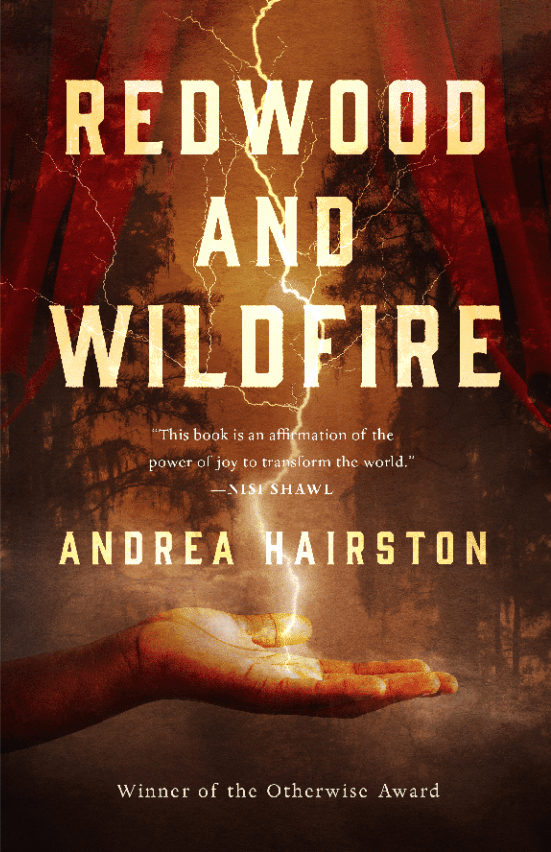REDWOOD AND WILDFIRE
Redwood and Wildfire is a novel of what might have been.
At the turn of the 20th century, minstrel shows transform into vaudeville which slides into moving pictures. Hunkering together in dark theatres, diverse audiences marvel at flickering images. This “dreaming in public” becomes common culture and part of what transforms immigrants and “native” born into Americans. Redwood, an African American woman, and Aidan, a Seminole Irish man, journey from Georgia to Chicago, from haunted swampland to a “city of the future.” They are gifted performers and hoodoo conjurors, struggling to call up the wondrous world they imagine, not just on stage and screen, but on city streets, in front parlors, in wounded hearts. The power of hoodoo is the power of the community that believes in its capacities to heal and determine the course of today and tomorrow. Living in a system stacked against them, Redwood and Aidan’s power and talent are torment and joy. Their search for a place to be who they want to be is an exhilarating, painful, magical adventure. Blues singers, filmmakers, haints, healers, and actors work their mojo for adventure, romance, and magic from Georgia to Chicago!
Nnedi Okorafor and Ishmael Reed, Meet Andrea Hairston
And her new novel, Redwood and Wildfire
By Carol Cooper
The Village Voice
published: February 23, 2011
For some time now there’s been hope that fresh directions in fantastic or speculative literature might come from black diasporic writers—that the world’s next Tolkien or Heinlein might be brown or beige. With her second novel, Redwood and Wildfire, Andrea Hairston edges up alongside Minister Faust and Nnedi Okorafor to become a serious contender for that role.Not that the inventive, manic energy that suffuses Hairston’s work is without precedent. Ishmael Reed’s first three novels: The Freelance Pallbearers, Yellow Back Radio Broke-Down, and Mumbo Jumbo were profoundly influential American satires whose stylistic DNA would show up in similarly political bestsellers as diverse as E.L. Doctorow‘s Ragtime and Shea & Wilson’s Illuminatus! trilogy. And while The New York Times lionized Mumbo Jumbo in 1972, they didn’t share my greater enthusiasm for Yellow Back Radio, a sardonic alt-history, which (as Hairston does here, although with gentler wit) strives to rewrite and redress the genocidal excesses of slavery and the Western ExpansionHairston—an award-winning playwright who teaches theater and African-American studies at Smith College—allows Reed’s innovations in tone, structure, and subject matter to help substantiate the literal “hoodoo” magic in Redwood and Wildfire. One of many themes Hairston weaves into her tale of an Irish-Seminole man (Aidan Wildfire) and a young black hoodoo queen (Redwood Phipps) who flee backwoods Georgia for urban Chicago at the turn of the 19th century is the importance of itinerant theater in shaping America’s evolving sense of itself.From black-face minstrel shows to multi-ethnic horse operas like Buffalo Bill’s Wild West, a unified cultural history was being forged, which this novel brings to life in vivid detail. Subsequent transitions from vaudeville to Broadway to movies locked iconic American performances into the group mind of audiences like a collective memory or dream. Using revelatory flashbacks and poetic asides, Hairston suggests such collective dreaming transforms people the same way herbal and psychological voodoo can. The fantasy elements featured in Hairston’s narrative—such as faith healing, telepathy, astral travel, and teleportation—are implicitly compared to the Promethean wonders of the electrical pavilion at the 1893 Chicago World’s Fair.Music is rightly described as yet another magic power; a way of changing peoples’ moods and even a person’s destiny. Using their mutual genius for period blues and bluegrass, Aidan and Redwood follow their dreams of self-reinvention along the same hazardous Blues Highway survived by Ma Rainey and Bessie Smith then transcended by Florence Mills and Josephine Baker. By the time this adventure ushers its characters into the pre-Code film industry, all that matters any more is transcendence: a physical and psychological transcendence of all obstacles to creative or social freedom.Both exhilarated and frustrated by working in motion pictures, Redwood and Wildfire think films should destroy ignorance and prejudice—not merely entertain. The entire book shows how these two slowly gain the life knowledge and confidence they need to believe in liberation through art—and then to project that belief into the hearts and minds of a live audience. As actors and “root workers” this becomes their ultimate magic trick. Hairston won’t even allow her star-crossed lovers to have sex until both believe in their ability to conjure a new and better world. Thus Redwood and Wildfire works as an allegory for all paradigm-shifting artistic innovation, even though it mostly reads as the love story of two people who struggle to invoke the free, interracial paradise that already exists in their hearts.
Andrea Hairston does reading/performances of Redwood and Wildfire with Pan Morigan. Check out the video “Peach” by Pan Morigan
